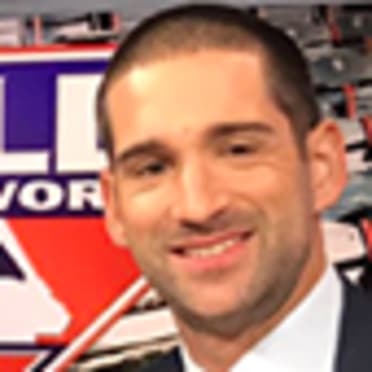Each team's best non-Top 100 prospect
It’s been nearly a week since MLB Pipeline unveiled its Top 100 Prospects for 2021, and in that time our Pipeline team has already answered many of your questions about the players who made the list.
But the very act of having to rank a finite number of prospects means that we also were forced to make some difficult omissions. And for some fans, finding out which players came close to making the Top 100 can be as interesting as the list itself.
With that in mind, MLB Pipeline has compiled a list of each team’s top prospect who didn’t make the 2021 Top 100. It also serves as a preview for the team Top 30 lists that we’ll be rolling out in March, with each player representing the next-highest-ranked prospect in their respective organization.
AMERICAN LEAGUE EAST
Blue Jays: Alejandro Kirk, C
Kirk introduced himself to a national audience four years after signing with Toronto for $7,500 out of Mexico in September 2016. The 5-foot-8, 265-pound backstop jumped from Class A Advanced Dunedin straight to the Major Leagues as a 21-year-old in 2020 and hit his first career home run as part of a 4-for-4 game. He’s an outstanding pure hitter with elite plate discipline -- a combination that helped Kirk record a .315/.418/.500 slash line with more walks (89) than strikeouts (60) in 151 Minor League games en route to his debut.
Orioles: Gunnar Henderson, SS
The Orioles’ second-round pick out of the Alabama high school ranks in 2019, Henderson was the youngest player at Baltimore’s alternate camp last summer, quickly adjusting and catching up to much more advanced pitching than he’d ever faced previously. He’s a big, strong left-handed hitter and super-athletic, and while the O’s think he can stick at shortstop, he’s also shown he could easily handle a move to third or center field.
Rays: Cole Wilcox, RHP
Though signability concerns caused Wilcox, a Draft-eligible sophomore, to drop to the No. 80 overall pick in last year’s Draft, he still commanded a third-round record bonus of $3.3 million from the Padres, who then sent him with Francisco Mejia, Luis Patiño and Blake Hunt to Tampa Bay for Blake Snell in December. Wilcox looks the part of a big league starter with his 6-foot-5 frame and potential for three plus pitches, though some scouts do wonder if he’ll end up in the bullpen on account of his delivery and below-average control.
Red Sox: Bryan Mata, RHP
Signed for just $25,000 out of Venezuela in July 2015, Mata pitched in the SiriusXM All-Star Futures Game at age 19 in 2018 and was the second-youngest pitcher in the Double-A Eastern League a year later. His best pitch is an electric 93-97 mph sinker, and he also can flash a plus slider and changeup as well.
Yankees: Deivi García, RHP
García arrived in New York last summer with a reputation for having one of the best curveballs in the Minors, but his slider was nearly as effective and he also had success with a high-spin fastball in the low 90s. A $200,000 signee out of the Dominican Republic in 2015, he averaged 12.7 strikeouts per nine innings in the Minors and recorded three quality starts in six tries with the Yankees.
AMERICAN LEAGUE CENTRAL
Indians: Bo Naylor, C
The Indians made Naylor the 29th overall pick in the 2018 Draft out of a Canadian high school mainly on the basis of his offensive potential, as his feel for hitting, bat speed and strength give him the chance to hit for both power and average. He has proven better than expected as a receiver and also has the solid arm strength to be an asset behind the plate.
Royals: Jackson Kowar, RHP
Kowar split his first full season in 2019 between Class A Advanced Wilmington and Double-A Northwest Arkansas, making 13 starts at each level while compiling an overall ERA of 3.52 in 148 1/3 innings. The 6-foot-5 right-hander already features a pair of impact pitches in his fastball and well-above-average changeup, and he reportedly made progress refining his curveball in 2020.
Tigers: Isaac Paredes, 3B
Originally signed by the Cubs out of Mexico for $500,000, Paredes was acquired by Detroit in the July 2015 deal that sent Justin Wilson and Alex Avila to the North Side of Chicago. He reached the Majors for the first time in 2020, making his debut at age 21, but ultimately struggled in 34 big league games, batting .220/.278/.290 with a 22.2 percent strikeout rate. But Paredes -- No. 10 on MLB Pipeline’s list of the Top 10 3B prospects – did appear to regain his form this offseason by leading the Mexican Pacific League in batting (.379) and OPS (1.060).
Twins: Jhoan Duran, RHP
The top pitching prospect at the Twins’ alternate camp in 2020, Duran came to the Twins from the D-backs in the 2018 Eduardo Escobar trade. His fastball, which touches triple digits, and his “splinker,” an absolutely nasty splitter/sinker hybrid, can get big league hitters out now and he’s made good strides with his breaking ball. If that continues, he’s sure to climb onto the Top 100.
White Sox: Jared Kelley, RHP
A Texas high schooler who was a consensus first-round talent in the 2020 Draft, Kelley unexpectedly fell to the second round, where the White Sox signed him for $3 million. The Gatorade national baseball player of the year, he generates 93-98 mph fastballs with ease and also possesses an advanced changeup with fade and sink.
AMERICAN LEAGUE WEST
Angels: Jordyn Adams, OF
The Angels’ first-round pick in 2018, Adams was a two-sport star who could have played football at the University of North Carolina. Early in his baseball career, he has shown a better feel to hit than anticipated. One of the youngest players at the Angels’ alternate camp last year, Adams’ raw power started to show up more along with an ability to make adjustments, all while using his ridiculous speed to make highlight-reel catches in center field.
Astros: Pedro Leon, OF
The Astros signed Leon, a Cuban defector, in January for $4 million, which is expected to be the largest bonus any player receives in the 2021 international class. He offers the upside of a 30-30 center fielder and has top-of-the-scale arm strength.
A’s: A.J. Puk, LHP
The A’s didn’t have a rep on the Top 100 this year, partially because Jesús Luzardo and Sean Murphy graduated, but also because Puk slid off. The No. 6 overall pick of the 2016 Draft, Puk spent four years on the Top 100, and pure stuff-wise, might still belong on the list. But concerns about his shoulder following surgery have clouded his future.
Mariners: Noelvi Marte, SS
After Marte posted a .309/.371/.511 slash line in his pro debut in the Dominican Summer League in 2019, everyone was excited to see his United States debut in 2020. The pandemic kept that from happening, which is a reason why he hasn’t performed his way onto the list, though he did carry himself well as the youngest player at the Mariners’ alternate camp. That time competing with and against more advanced competition could bode well for a huge breakout in 2021.
Rangers: Leody Taveras, OF
A mainstay on MLB Pipeline's All-Defense team, Taveras made the Rangers ahead of schedule at age 21 last year because of his prowess in center field. Signed for $2.1 million out of the Dominican Republic in 2015, he lived up to his reputation with the glove and also hit the ball with more authority than he had in the Minors.
NATIONAL LEAGUE EAST
Braves: Braden Shewmake, SS
The second of two first-round picks in 2019, Shewmake jumped on a fast track during his summer debut by hitting .318/.389/.473 with 11 steals in the Class A South Atlantic League and getting moved up to Double-A to finish off the year. He has an advanced approach from the left side of the plate with power to come and has the instincts to stick at shortstop.
Marlins: Jesús Sánchez, OF
Acquired along with Ryne Stanek from the Rays in July 2019 in exchange for Nick Anderson and Trevor Richards, Sánchez has the left-handed stroke, bat speed and knack for contact to become a .280 hitter with 25 homers annually. To get there, he'll need to improve his discipline, as big leaguers exposed his impatience while he went 1-for-25 in his debut last summer.
Mets: Pete Crow-Armstrong, OF
Scouts viewed Crow-Armstrong as perhaps the best defensive outfielder available in the 2020 Draft before the Mets took him at No. 19 overall. The 18-year-old center fielder is a dynamic athlete who plays hard and gets to everything hit in the air with his plus speed, first-step quickness and preternatural feel for reading the ball off the bat. He also can swing the bat, showing the potential to hit for average and possibly some power, too, as he grows into his ultra-athletic and projectable frame.
Nationals: Jackson Rutledge, RHP
Rutledge was perhaps the best junior college prospect in the country in 2019, posting a 0.87 ERA with 134 strikeouts in 82 2/3 innings for San Jacinto (Texas) to become the No. 17 pick in that year’s Draft. The 6-foot-8 right-hander has a pair of electric offerings in an upper-90s fastball and a wipeout slider and became more of a complete pitcher at Washington’s alternate training site in 2020, with improvements in Rutledge’s delivery allowing him to throw more strikes and make strides in developing his curveball and changeup.
Phillies: Bryson Stott, SS
Stott was on the Top 100 last year, and the 2019 first-round pick out of UNLV narrowly missed the cut this time around, which is more of a testament to others passing him than anything negative about his performance. He’s a solid all-around performer who has the chance to hit for average with some pop while staying up the middle defensively.
NATIONAL LEAGUE CENTRAL
Brewers: Hedbert Perez, OF
Perez’s $700,000 bonus was the second-largest that the Brewers gave to an international prospect during the 2019-20 period, and it’s already looking like money well spent. He was a standout during instructional league in 2019 in his first taste of pro ball and continued to impress Brewers officials last year despite being the youngest player (17) at Milwaukee’s alternate site. He has one of the higher ceilings in the system as a five-tool center fielder who projects to hit for both average and power from the left side of the plate.
Cardinals: Ivan Herrera, C
MLB Pipeline’s No. 10-ranked catching prospect for 2021, Herrera has improved every season since he signed with the Cardinals for $200,000 out of Panama in July 2016. He batted .284/.374/.405 as an 18-year-old at Class A Peoria in 2019 and continued to make developmental gains on both sides of the ball in 2020, gaining valuable experience at the Cardinals’ alternate training site.
Cubs: Ed Howard, SS
The top true shortstop prospect in the 2020 Draft, Howard went 16th overall to his hometown Cubs six years after leading Chicago's Jackie Robinson West squad to the Little League World Series finals. He's a smooth defender with projectable strength and solid speed, so he should contribute on both sides of the ball.
Pirates: Liover Peguero, SS
The Pirates got Peguero from the D-backs in the Starling Marte trade last January and he was the youngest participant in their alternate camp in 2020. There, he made some excellent adjustments to the higher level of competition (he’s yet to play above Class A Short-Season). Just 20 years old for all of the 2021 season, Peguero has the chance to be a plus hitter and made some highlight reel level plays at shortstop in Altoona last summer.
Reds: Jonathan India, 3B
India was the No. 5 pick in the 2018 Draft, largely because of his advanced bat and power potential. But he suffered through a rough first full season, even though he did reach Double-A, largely because of a nagging wrist issue he tried to play through. Completely healthy, he was the best hitting prospect at the Reds’ alternate camp and has the chance to really show what all the fuss was about in 2021.
NATIONAL LEAGUE WEST
D-backs: Slade Cecconi, RHP
Arizona took a college hurler with its first two picks in 2020, selecting Duke’s Bryce Jarvis in the first round (No. 18 overall) followed by Cecconi, a University of Miami Draft-eligible sophomore, in the first competitive balance round (No. 33). Cecconi’s stuff was better than advertised at the alternate training site and instructional camp, as the 6-foot-4 right-hander showed that he could command his mid-90s fastball well, pairing it with a plus slider as well as a curveball and changeup that show promise.
Dodgers: Michael Busch, 2B
One of the best all-around hitters in the 2019 college crop, Busch went 31st overall out of North Carolina. His combination of hitting ability, power and plate discipline would allow him to profile offensively at any position, and he's enhancing his value by improving his athleticism and chance to stick at second base, his best-case position.
Giants: Seth Corry, LHP
Corry allowed just 11 runs (nine earned) in his final 14 starts of 2019, en route to leading the low Class A South Atlantic League in ERA (1.76), strikeouts (172), strikeouts per nine innings (12.6), whiff rate (34 percent) and opponent average (.171). The 2017 third-rounder from a Utah high school works with a low-90s fastball that reaches 96, a downer curveball and an improving changeup.
Padres: Ryan Weathers, LHP
After fatigue issues had caused Weathers’ velocity to dip into the 89-91 mph range during his first full season, the former No. 7 overall pick (2018) was a much different pitcher at San Diego’s alternate training site in 2020, operating with mid-90s velocity and a sharper breaking ball. That uptick in stuff and stamina helped Weathers earn a spot in the Padres’ NLDS bullpen against the Dodgers, and he subsequently made his big league debut in the series at age 20, despite having never pitched above the Class A level.
Rockies: Ryan Rolison, LHP
The Rockies’ first-round pick in 2018, Rolison has been in this “next up” for the Top 100 group for two years in a row. He has a solid but not eye-popping four-pitch mix (though his curve is plus) and an idea of how to use all of his pitches well. He could easily pitch his way to Colorado quickly in 2021.


